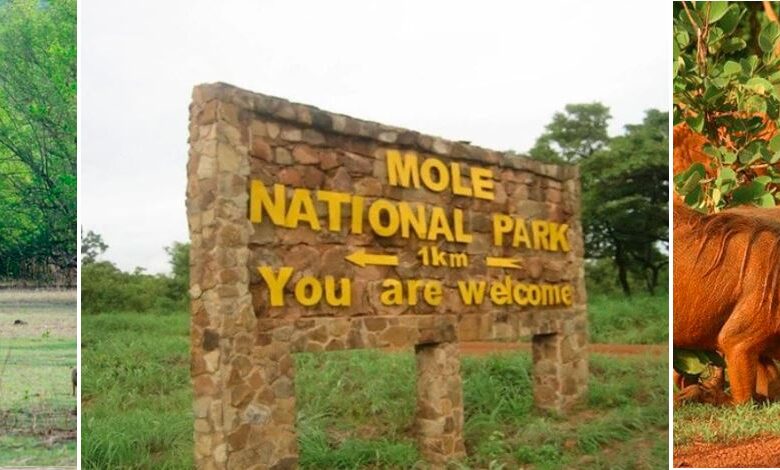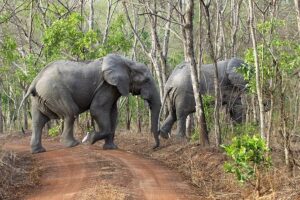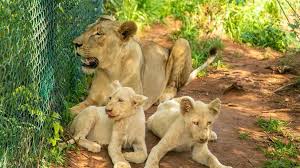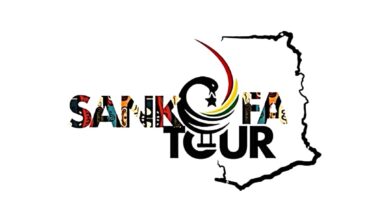THE NATURE LOVER’S TREASURE TROVE “MOLE NATIONAL PARK”

Mole National Park (pronounced ‘Moh-lay’), is the nature lover’s treasure trove! Located within the Savanna region is Ghana’s first, largest wildlife conservational area. And it is the most prestigious and protected area.
The Park has the most viable elephant population in Ghana, and as such, is a hotspot for elephant conservation. It is also said that the Park has a unique breed of elephant, which are not hostile, not aggressive or insecure, compared to other elephant populations in the rest of Africa.
Mole National Park was the first Wildlife Protected Area to be established in Ghana. The Park lies within two physiographic regions – 65% lies within the Voltaian sandstones basin and 35°/0 within the savannah high plains. The topography is generally undulating with flat topped hills which is dominated by the Konkori scarp that runs north-south through the park and reaches up to250m a.m.s.1. The Park forms part of the Volta River catchment and numerous rivers cross or originate in it to drain into the White Volta River. Mole National Park represents a fairly undisturbed guinea Savannah ecosystem dominated by open savannah woodland. The park has very rich flora and fauna.
Over 93 species of mammals, about 400 species of birds, 9 amphibians, 33 reptilian and several insectivorous species and 5 endemic butterfly species have been recorded. Species of special interest include Elephant, Buffalo, Kob, Western Hartebeest, Roan Antelope, Defassa Waterbuck, Oribi, Bohor Reedbuck and Red-flanked Duiker. The riverine forests are home to rare and endangered species such as Yellow-backed Duiker and Black and White Colobus monkey. The Lion, Leopard and Hyena are important large carnivores found in the reserve. The buffalo population is of great scientific interest since both black and red colour varieties exist in the Dark.
African bush elephants and antelopes are among the prominent wildlife found at the Mole National Park. According to research completed on the park, there are around 800 elephants in the Mole National Park. Burkea Africana, Isoberlinia Doka, and Terminalia Macroptera are some of the tree species that may be found in the forest. While elephants and antelopes dominate the forest’s wildlife, other creatures such as buffalos, and hippos can also be found there, albeit in tiny numbers
With regards to vegetation, local endemism is generally low in West African Savannah, and only two endemic species Kyllinga echinata, a sedge and Ancilema setiferum var pallidiciliatum confined to northern Ghana, are found in Mole. In addition, three species endemics to Ghana are recorded, namely Gongronema obscurum, Raphionacme vignei and Phinopterys angustifolia.
Eleven (11) species of mole are confined to the savannah woodland while Mimusops kammel, a tree that is confined to riverine forests. To date, five species have been identified whch have not been recorded elsewhere in Ghana Croton pseudopulchellus, Indigofera conferta, Indigoera trichopoda, Jatropha neriifolia and Pleiotaxis newtonii. Anthocleista vogelii, a tree of wet sites in the south-western forest zone of Ghana has been recorded for the first time in Mole. Apodostigma palleus is a climber that is also restricted to the forests in the south-west Ghana. Amblygono carpas andogeneiss, a savannah tree widespread in central, east and south tropical Africa, has been recorded for the first time in Ghana at Mole.
Mole has an important history linked to the national slave trade route project. The ancient caravan route from Salaga to Wa and beyond to Mali, passed through the heart of the park. This route was used for both trading and to transport slaves to coastal markets. The park Headquarters is located right at a place where two famous slave raiders (Samore and Babatu) raided and erased a village to the ground. The Head quarters is named after one of them – Samole. There is a cave in the Konkori escarpment that was used as a refuge from slave raiders by the local indigines. Other important attractions in the park include Kwomwoghlugu and Asibey pools, wetland areas (unique bird-watching sites), waterfalls on the Koukori escarpments and remains of many old villages destroyed by slave raiders.

The park’s entrance is reached through the town of larabanga. The Levi and Mole Rivers are ephemeral rivers flowing through the park, leaving behind only drinking holes during the long dry season. This area of Ghana receives over 10 mm per year of rainfall. A long-term study has been done on Mole National Park to understand the impact of human hunters on the animals in the preserve. Residents of the Savanna Region used to live in the Mole National Park’s current site, but they were relocated to make room for the land to be used as a reserve.

Mole is one of seven National Parks in Ghana. The other wildlife estates include six Resource Reserves, two wildlife sanctuaries, one Strict Nature Reserve and five Ramsar sites, managed by the Wildlife Division of the Forestry Commission of Ghana. The Park’s mission is to sustainably manage the wildlife resources of Mole National Park, increase revenue, and generate economic activities around the Parkpark with a view to contribute towards local socio-economic development.
Effective law enforcement and protection of the Parkpark is ensured through the establishment of the range system, and collaboration with fringe communities. Today, Mole National Park is inscribed on UNESCO’s Tentative List of World Heritage Properties in 2000 and is working and striving to achieve World Heritage Site status soon.
The Park is accessible by road. It also has an airstrip, which is out of use.
SAFARI
Visitors to this prestigious park, also have the opportunity the Safari available. Tourists can opt for tree hide, foot safari, drive safari or night safari.
NIGHT SAFARI
The night safari begins at exactly 6:00pm and last for about an hour. In order not to disturb the animals unduly, an armed guide in a rental jeep escorts visitors on this adventure which is booked for at the information Centre. Visitors have the choice of viewing the animals from the roof of the jeep or from inside as most of the rental jeeps have roof top seatings. Some of the animals that visitors may see on this safari include: buffalos, hyenas, roans, antelope, leopard, elephants and hartebeest.
DRIVE SAFARI
The drive safari involves a drive through the park. If you ride on or in a Jeep, you are likely to see more animals than you would if you were walking. And you would certainly cover a large distance in a shorter space of time. Animals that you may likely see on a day safari include: birds, roans, antelopes, elephant, baboons, warthogs and monkeys. Day safari are conducted between the hours of 7:00 am and 11:00 am and between 3:30 pm and 5:30 pm. Each trip lasts for two hours.
TREE HIDE
Hyenas, buffaloes, baboons, leopard, antelopes and birds are some of the animals you might see. Throughout the night there are over a hundred birds chirping and this combined with the cries of hyenas and baboons is very exciting for any animal lover. The tree hide experience begins at the information center with an hour walk to the tree hide at 5:00pm with an armed guide who will remain with the visitors for the entire period of their stay at the tree hide. The tree hide experience ends at 8:00 am the following morning. There is a borehole near the tree hide for those who would like to take their bath before setting off. Visitors are advised not to wear light clothing as there are tsetse flies on the road to the tree hide and tsetse flies are able to bite through clothing. A double layer of the clothing, long trousers, socks, boots and insects’ repellent will come in handy on your journey.

CAMPING
Mole National Park has a public campsite where visitors who would love to have a bit more adventure can mount tents and spend the night. This is the largest campsite in the park, and it is sited by the Park Headquarters, near Mole Motel. There is a designated open space for camping, with bathroom and toilet facilities, within walking distance of the Information Centre. For a bird’s eye view of a part of the park, there is a viewing platform with seating area. Tents and mosquito nets can be rented from the Park’s Information Centre.
Visitors can also camp at Brugbani Camp, which is also at the Headquarters Range.
ACCOMODATION
Tourist coming outside Damango and thinking of where to stay at night have their fears resolved. The mole motel and Zania motel provides accommodation for people who would like to spend the night inside the park.
Mole offers you a truly peaceful setting for relaxation while enjoying the wonders of nature and warmth of local hospitability. And an experience to always cherish.
Writer: Agudie Amankwah




